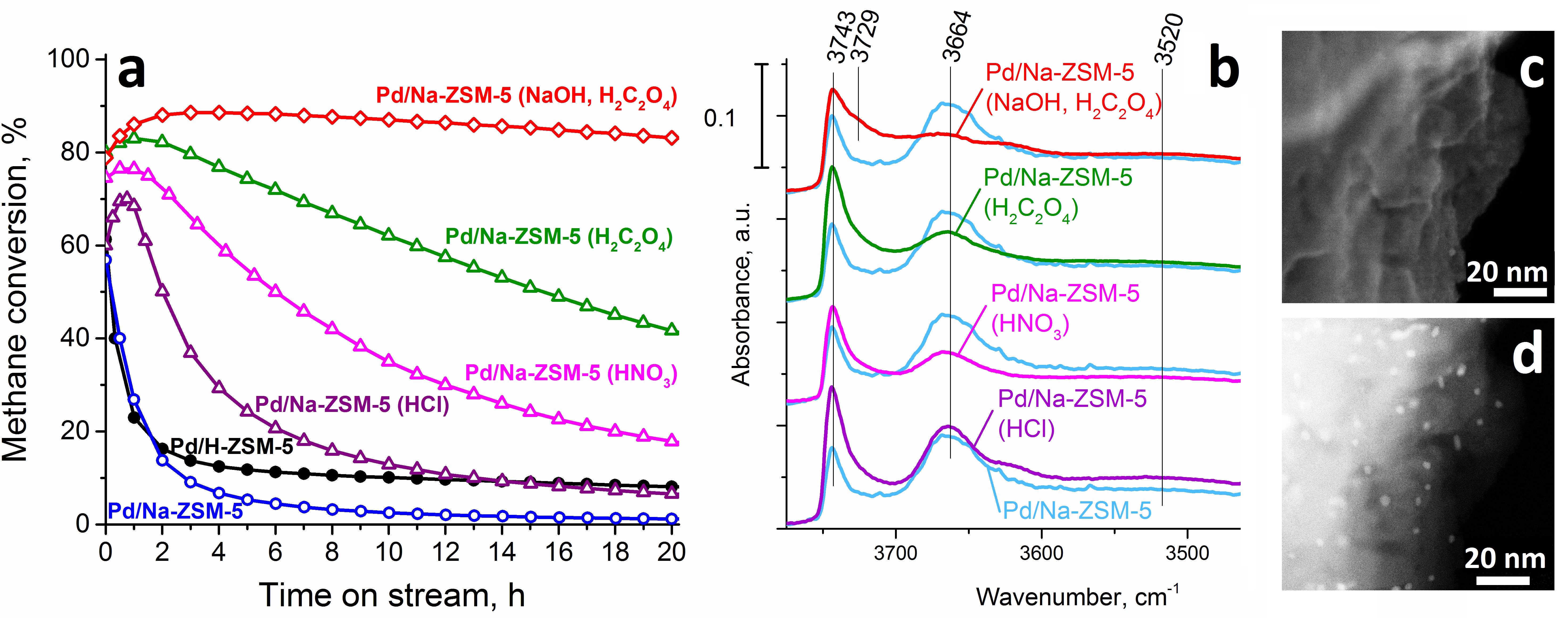Rational design of Pd/Na-ZSM-5 catalysts for complete methane oxidation
Stabilization of metal nanoparticles in a constrained internal space of a support has attracted considerable attention in the recent years [1], allowing to reduce the production costs by decreasing the amount of the active metal. In this work, we have exploited this approach in order to prepare active and stable methane oxidation catalysts, which currently lack low-temperature activity and long-term stability due to metal nanoparticle sintering [2], for possible utilization in catalytic converters to treat the exhaust of natural gas fueled vehicles. Moreover, we defined the activity and stability descriptors for the novel fully sodium exchanged Pd/Na-ZSM-5 catalysts using various zeolite post-modification techniques.
Dealuminated ZSM-5 zeolites were obtained by leaching the parent material (Clariant SM-27, Si/Al=12) with HCl, HNO3 and oxalic acid. Mesoporous ZSM-5 was obtained by consecutive base and acid leaching. The thus treated zeolites were then exchanged with salts of Pd and Na to achieve 1 wt. % palladium and to fully exchange the acid sites of the zeolite. The stability of the catalysts was evaluated in a quartz glass plug-flow reactor with a feed of 1 vol.% CH4, 4 vol.% O2 and 5 vol.% H2O (bal. N2) at 420oC and GHSV = 80,000 h-1.
Transmission IR spectra (Fig. 1b) of acid washed Pd/Na-ZSM-5 revealed different Al extraction mechanisms by the acids. Whereas HCl caused unselective surface and bulk dealumination of the framework (as evidenced by the increase of the peaks corresponding to the terminal Si-OH at 3743 cm-1 and H-bonded Si-OH groups at 3520 cm-1), oxalic acid caused only surface dealumination [3]. Both HNO3 and oxalic acid significantly reduced the amount of extra-framework aluminum (EFAL, 3664 cm-1). The better performance of the samples washed by HNO3 and oxalic acid (Fig. 1a) suggests that EFAL species passivate Pd/Na-ZSM-5 catalysts. Generation of a small amount of mesopores (nanocages) by desilication together with the control of aluminum speciation yielded a highly active and stable catalyst. Microscopic investigation confirmed that this was achieved by trapping palladium particles within the nanocages of the zeolite (Fig. 1c,d).
The results show that achieving high performance of Pd/Na-ZSM-5 requires, besides the complete Na exchange, control of Al speciation and pore structure of the zeolite.

Figure 1. (a) Catalytic performace, (b) transmission IR spectra of various Pd/Na-ZSM-5. (c) Secondary electron and (d) transmission electron microscopy images of base-acid leached Pd/Na-ZSM-5.
[1] D. Farrusseng, A. Tuel, New J. Chem. 2016, 40, 3933-3949.
[2] A.W. Petrov et. al., Top. Catal. 2017, 60, 123-130.
[3] A. Omegna et. al., Phys. Chem. Chem. Phys. 2004, 6, 447-452.